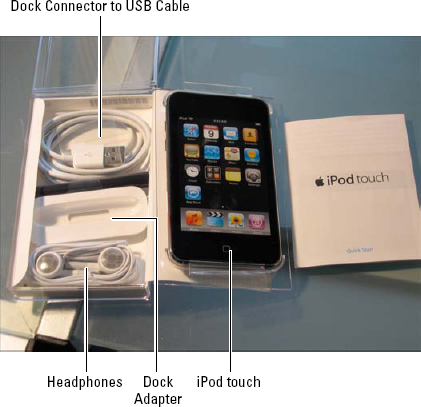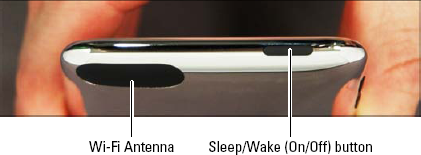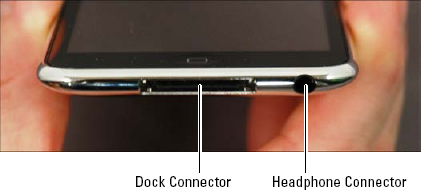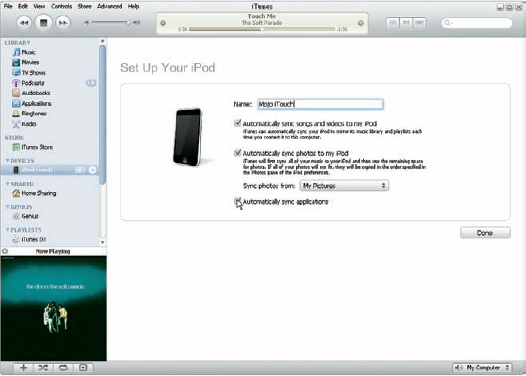Looking inside the box
Finding out what your iPod touch is good for
Connecting to your computer and iTunes
Using and recharging your battery
You hold in your hands the greatest portable music player in the world, which also happens to be the greatest portable video and game player. But that's not all: With built-in wireless Internet connectivity, the iPod touch defines an entire new class of ... thing.
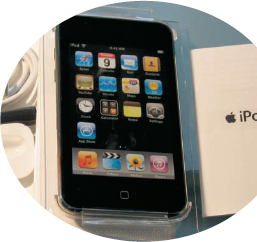
I want to call it a device, but it's so much more — the iPod touch puts the entire world in your pocket. Not only can you download tunes and games directly to your iPod touch, but you can also select from a library of over 85,000 applications (known as apps) that offer everything from soup to nuts. Apps come in the form of databases that serve up local restaurants based on your location; utility programs that connect you with social networks like Facebook; and a plethora of navigation, lifestyle, health, sports, reference, finance, productivity, and travel aids. Apps even let you send and receive e-mail and visit your favorite Web sites.
Less than a third of an inch thick and weighing only 4 ounces, the iPod touch is really a pocket computer — it uses a flash memory drive and an operating system that can run applications. It shares the design characteristics and many of the features of its more famous cousin, the iPhone, with the same built-in speaker and volume controls on the left side and the same touch-sensitive glass display. And it can do nearly everything an iPhone can do, except make cellular-service phone calls and pinpoint its exact location with the Global Positioning System (GPS). Even so, the iPod touch can pinpoint its approximate location with Internet-based location services, and you can make phone calls using the Skype app, an Internet connection, and an external microphone. It also offers stereo Bluetooth for using wireless headphones and microphones.
So what's in the box, and what can it do?
Apple excels at packaging. Don't destroy the elegant box while opening it, and check to make sure that all the correct parts came with it, as shown in Figure 1-1. Keep the box in case, heaven forbid, you need to return the iPod touch to Apple — the box ensures that you can safely return it for a new battery or replacement.
The iPod touch is supplied with the following:
The cable connects your iPod touch (or its dock) to your computer or to the AC power adapter using a USB (Universal Serial Bus) connection — a way of attaching things to computers and bussing data around while providing power. The cable has a USB connector on one end and a flat dock connector on the other end to connect either to a dock or directly to an iPod touch.
There are a few things you may want to have around that are not in the box. For example, even though you don't really need an AC power adapter or dock — you can connect the iPod touch directly to your computer to recharge your battery — a power adapter or dock is useful for keeping the battery charged without having to connect the iPod touch to your computer.
The earbuds supplied with your iPod touch may not suit your tastes, but there are a hundred other headphone products that might. You can get all kinds of accessories, including headphones, speakers, the Apple Universal Dock, other docks, and AC power adapters, from the online Apple Store (www.apple.com/store), the physical Apple Store, or other stores such as Amazon.com and Frye.
You still need a computer and iTunes to manage your content and your iPod touch. These things are not in the box, obviously.
You've seen requirements before — lots of jargon about MB (megabytes), GB (gigabytes), GHz (gigahertz), and RAM (random access memory), sprinkled with names like Intel, AMD, and Mac OS X. Skip this section if you already know your iPod touch works with your computer and you already have iTunes. But if you don't know whether it will work, and you don't have iTunes yet, read on.
You need the following:
A PC or Mac to run iTunes: On a PC, iTunes version 9 (version 9.0.1 as of this writing) requires Windows XP (with Service Pack 2) or a 32-bit edition of Windows Vista, running on a 1GHz Intel or AMD processor with a QuickTime-compatible audio card, and a minimum of 512MB of RAM; 1GB is required to play HD-quality videos, an iTunes LP, or iTunes Extras from the iTunes Store. You need a DirectX 9.0–compatible video card with 32MB of video RAM (64MB recommended) to watch video, and a 2GHz Intel Core 2 Duo or faster processor to play HD-quality videos, an iTunes LP, or iTunes Extras. The 64-bit editions of Windows Vista require the iTunes 9 64-bit installer, available for downloading from the iTunes download page.
With a Mac, iTunes version 9 runs on all versions of Mac OS X (Leopard and Snow Leopard or newer versions), and on older Mac OS X Tiger versions 10.4.11 or newer version. You need a 500 MHz processor or better (Intel or PowerPC), and at least 512MB of RAM; 1GB of RAM is required to play HD-quality videos, an iTunes LP, or iTunes Extras from the iTunes Store. You also need an Intel PowerPC G5 or a 1GHz PowerPC G4 or faster processor, with 16MB of video RAM, to play videos; and a 2GHz Intel Core 2 Duo or faster processor to play HD-quality videos, an iTunes LP, or iTunes Extras.
USB connection: You need a USB 2.0 connection (also called a high-powered USB) on your computer. All current-model Macs and many PCs provide built-in USB 2.0.
iTunes: Make sure you have the current version of iTunes, which also includes QuickTime for playing video. You can download iTunes for Windows or the Mac from the Apple site (
www.apple.com/itunes/download); it's free.
Play music, audio books, videos, and games; communicate with friends in social networks; make travel reservations and see maps of the entire world; check the weather and your finances; and keep track of all your appointments. You can do all this and much, much more by using apps and connecting to the Internet.
Portable DVD players are cute, but they don't come anywhere close to being as convenient as an iPod touch for playing video. The iPod touch is the Swiss Army Knife of media: It plays music, music videos, TV shows, movies, audio books, slideshows, and podcasts (audio and video episodes designed to be downloaded to your iPod touch).
The convenience of carrying content on an iPod touch is phenomenal. For example, the 32GB iPod touch can hold around 7,000 songs. That's more than a week of nonstop music played around the clock.
Apple offers the following sizes of iPod touch models as of this writing:
All three models use the same battery that offers up to 36 hours of music playback, or 6 hours of video playback.
Note
For a nifty chart that shows the differences between iPod models, see the Identifying iPod Models page on the Apple iPod Web site (http://support.apple.com/kb/HT1353).
How do you get 14,000 songs (or for that matter, any number of songs) onto your iPod touch quickly? If you have an iTunes library of songs, you can fill up your iPod touch by connecting it to your computer (as I describe later in this chapter) and synchronizing it with iTunes (as I describe in Chapter 5). You can also download songs from the iTunes Store, as I describe in Chapter 4.
Even audio books and videos — some of your favorite TV shows, plus music videos and full-length movies — are just a touch away on your iPod touch, or a click away in iTunes.
Note
You use iTunes to organize your content, make copies, burn CDs, and play disc jockey without discs. To find out more, see my other book, iPod & iTunes For Dummies (Wiley Publishing, Inc.).
The iPod touch can also show pictures. Its 3.5-inch, widescreen, multi-touch display offers 480-x-320–pixel resolution at 160 dots per inch for crisp photos and video pictures. You organize your photos on your computer and then transfer them to your iPod touch using iTunes, as I describe in Chapter 9.
Your iPod touch can sense Wi-Fi networks. (Wi-Fi, short for wireless fidelity, is a popular connection method for local area networks and the Internet; you can set up your home or office with Wi-Fi using an inexpensive Wi-Fi hub, such as Apple's AirPort Extreme.) After it finds one or more networks, the iPod touch lets you choose one to connect to the Internet, and it can remember the settings for that network so that it can automatically choose the same network again.
With a Wi-Fi connection, you can use the Safari app to browse the Web and interact with Web services, and you can use the Mail app to send and receive e-mail. Stocks, Maps, and Weather are apps that show information from the Internet. You can also use the YouTube app to play YouTube videos on the Web. All these apps are supplied with your iPod touch.
You can download more apps to your iPod touch by connecting to Wi-Fi and the Internet, and tapping the App Store icon. You can download music, videos, and podcasts by tapping the iTunes icon, as I describe in Chapter 4.
You also use apps to connect to the Internet in other ways than browsing. For example, popular social networks such as Facebook and MySpace offer apps to connect you with your friends on those services. Google offers an array of services through the Google Mobile app, including the ability to edit documents and spreadsheets, use the Gmail service, and share calendars and photos. The Twitterific app lets you post tweets on Twitter, and the WhosHere and Loopt apps can connect you directly to other iPod touch and iPhone users for chatting.
Many of the apps you'll find listed at the App store are especially designed to take advantage of three distinct features of the iPod touch: its multitouch display; its accelerometer (which detects acceleration, rotation, motion gestures, and tilt); and its ability to detect its physical location.
For example, Motion X Poker — actually a dice game — uses the accelero-meter to let you roll the dice by shaking the iPod touch. The Flick Fishing app senses motion so you can cast a fishing line with a flick of the wrist. And for really precise motion, try rolling a steel ball over a wooden labyrinth of holes in the free Labyrinth Lite app.
Sensing your iPod touch's location is a very useful feature. The Showtimes app uses your iPod touch's location to show the movie theaters closest to you. The Eventful app uses your location to display local events and venues, and the Lethal app can tell you the dangers which could surround you — the hostile animals, the likelihood of crimes, the prevalence of disease, and the potential accidents and disasters.
So now you know a bit about what the iPod touch can do. It's time to fire up this baby and start rockin' out.
Awaken your iPod touch by pressing the Sleep/Wake (On/Off) button, which is located on the top of the iPod touch, as shown in Figure 1-2. (The black oval on the back and near the top is the Wi-Fi antenna — don't cover this up if you're trying to access Wi-Fi.)
If you press the Sleep/Wake (On/Off) button again, it puts the iPod touch back to sleep and locks its controls to save battery power.
You can turn the iPod touch completely off by holding down the Sleep/Wake (On/Off) button for about two seconds, until you see the Slide to Power Off slider; then slide your finger across the slider to turn it off. You can then turn it back on by pressing and holding the Sleep/Wake (On/Off) button. To save battery power, you should plug the iPod touch into AC power or your computer before turning it back on from a completely off state. (For battery details, see the "Facing Charges of Battery" section in this chapter.)
You can supply power to your iPod touch (and charge your battery at the same time) by using the provided cable and your computer, or you can use an optional AC power adapter that works with voltages in North America and many parts of Europe and Asia.
On the bottom of the iPod touch, you find one large connection called the Dock Connector and a smaller connection for headphones, as shown in Figure 1-3. The Dock Connector mirrors the connection on the end of a dock — your iPod touch fits snugly in a dock, and then the dock offers the Dock Connector for your computer.
Tip
Do you want your iPod touch to stand upright? Just connect it to an Apple or a third-party dock and then use the cable supplied with your iPod touch to connect the dock to your computer or power adapter. The dock keeps your iPod touch in an upright position while connected and also provides connections for a home stereo or headphones. Some docks offer built-in speakers. A dock can be convenient as a base station when you're not traveling with your iPod touch, because you can slip it into the dock without connecting cables. You can pick up a dock at an Apple Store, order one online, or take advantage of third-party dock offerings.
To connect your iPod touch to your computer, plug the flat connector of the supplied cable into the iPod touch Dock Connector (refer to Figure 1-3), and then plug the USB part on the other end into the USB port on your computer.
You can connect the USB end of the supplied cable to either the Apple (or third-party USB) power adapter for power, or to the computer's USB 2.0 port for power. As soon as you connect it to the computer, iTunes starts up and begins syncing the iPod touch (see Chapter 5). After syncing, the computer continues to provide power through the USB 2.0 port to the iPod touch.
Why USB 2.0? What happened to 1.0? Most PCs and all current Macs already have USB 2.0, which is all you need to provide power and to sync an iPod touch with your computer. Although you can use a low-powered USB 1.0 or 1.1 connection to sync your iPod touch, it doesn't supply enough power to charge the iPod touch battery, and it's slower than molasses for syncing on a subzero morning.
Warning
Don't use another USB device in a chain and don't use a USB 2.0 hub to connect your iPod touch unless the hub is a powered hub — a hub with a separate power source, in other words. Note that a USB keyboard typically acts like a USB 1.1 hub, but it's not powered, so it can't provide power to the iPod touch.
After adding power, your iPod touch comes alive and displays the image of the USB cable and the iTunes icon. This is a simple message telling you to connect the iPod touch to iTunes on your computer.
iTunes is the software that manages your library of content and apps on your computer, and enables you to sync apps, content, and personal information with your iPod touch, as well as update the iPod touch software and restore it to original factory settings if you need to.
Macs already have iTunes, and setting up iTunes on a Windows PC is a quick and easy process. The most up-to-date version of iTunes as of this writing is version 9.0.1. However, software updates occur very rapidly. If you really want the latest version, go directly to the Apple Web site (www.apple.com/itunes) to get it. You can download iTunes for free.
For details on how to install iTunes, see the instructions on Apple's Web site or see my other book, iPod & iTunes For Dummies.
Be aware that, for your new iPod touch and iTunes to play nice with each other, you first have to get iTunes to recognize your new device; they have to be introduced, in other words. You do that by using the Register and Set Up screen, as spelled out in the following steps:
With iTunes open, connect your iPod touch to the computer with a USB cable.
iTunes recognizes the iPod touch and opens the Register and Set Up screen to get you started.
If the iPod touch isn't recognized in a few minutes, make sure it's charged. A lightning bolt battery icon appears when it's asleep and connected to power — if you don't see this icon, iPod touch isn't charging properly, and you may need to try a different cable or try a different USB 2.0 connection. (For more battery details, see the section "Facing Charges of Battery" in this chapter.) If the iPod touch is charged and still not recognized, try putting it to sleep and waking it again (see the preceding section). If that doesn't make your iPod touch recognizable by iTunes, try resetting your iPod touch as described in Chapter 14. If all else fails, try restarting your computer, and if that doesn't help, try re-installing iTunes. Finally, contact Apple Support to return your iPod touch for repair (
www.apple.com/support).Click Continue (or click Register Later to skip the registration process).
iTunes displays the License Agreement. You can scroll down to read it if you want. You must choose to accept the agreement, or the installer goes no further. (If you click to Register Later, you get to skip a few screens in the set-up process, but you don't get to skip the license agreement.)
Tip
I don't recommend skipping the registration screens unless you intend to register the device later; registration helps you get better service from Apple in case you need it.
Click the option to accept the terms at the end of the License Agreement and then click Continue.
After clicking Continue, iTunes lets you register your iPod touch with Apple online so you can take advantage of Apple support. You see a screen for entering your Apple ID; a membership ID for the MobileMe (formerly .Mac) service is also valid.
Select the option (Use My Apple ID to Register My iPod or I Do Not Have an Apple ID) that applies to you and fill in the info beneath that option.
How you handle this step depends on how you purchased your iPod touch. Here's the scoop:
If you purchased your iPod touch directly from Apple and you have an Apple Store or MobileMe ID, select the Use My Apple ID to Register My iPod option and enter the ID and password to swiftly move through the registration process. Apple automatically recognizes your purchase so that you don't need to enter the serial number.
If you bought your iPod touch elsewhere or you don't have an Apple ID or MobileMe ID, select the I Do Not Have an Apple ID option. If needed, select your country from the pop-up menu below that. When you click Continue, iTunes displays a screen for entering your iPod touch serial number and your personal information. Fields marked with an asterisk (*) are required, such as your name and e-mail address.
Tip
Got a magnifying glass? You can find the iPod touch serial number on the back of the device or on the side of its packaging.
Click Continue to advance through each screen in the registration process and click Submit at the end to submit your information.
iTunes checks to see whether you've ever backed up an iPod touch before. If you've synced an iPod touch previously, as I describe in Chapter 5 (and you haven't deleted its backup as I describe in Chapter 14), iTunes gives you the following choices:
Set Up As a New iPod: Select this option if you want to set the iPod touch up as new, and then click Continue. iTunes displays a screen that lets you enter a name for your iPod touch, as shown in Figure 1-4.
If you've synced an iPod touch previously on the same computer, select the Restore From the Backup Of option and select the previous iPod touch from the pop-up menu. Alternatively, select the Set Up As a New iPod option.
Give your iPod touch a name, set the automatic options, and then click Done (on a Mac) or Finish (on Windows).
It's nice to give your iPod touch a name to give it more of a personality. And when it comes to setting automatic options (refer to Figure 1-4), here's the deal:
Automatically Sync Songs and Videos to my iPod: If you want to copy your entire iTunes music and video library onto your iPod touch, leave this option selected. If you want to control which portion of your library is copied to the iPod touch, deselect this option and turn to Chapter 5 for synchronization details.
Automatically Sync Photos to my iPod: Select this option to copy all the photos in your Pictures folder or photo library to your iPod touch, and select the photo library or folder in the Sync Photos From pop-up menu. (See Chapter 9 for information about synchronizing photo libraries.) Leave it deselected if you want to transfer photos later.
Automatically Sync Applications: Select this option to copy all iPod touch apps in your iTunes library to your iPod touch.
Don't want to add songs or videos now? If you deselect the option to automatically synchronize (refer to Figure 1-4), you can still add songs and videos later, along with podcasts and audio books — either manually or automatically, as I describe in Chapter 5.
After finishing setup, your iPod touch name appears in the iTunes Source pane (the left column) under the Devices heading (refer to Figure 1-6. Click this name to display information about your iPod touch in the main part of the iTunes window. The information you see also includes a message to update your iPod touch if Apple has an update for it. If you see this message, click the Update button to update your iPod touch. If you have an earlier model iPod touch, you can download the iPhone Software update (sold seperately) to bring it up to date. See Chapter 14 for details.
If you chose the option to automatically synchronize your songs and videos, your iPod touch quickly fills up with music and videos from your iTunes library.
You can leave your iPod touch connected to the computer, using the computer as a source of power — the iPod touch appears in iTunes whenever you start iTunes.
To disconnect it from iTunes and your computer, click the eject button next to the iPod touch name (refer to Figure 1-4) in the Source pane. (The eject button shows a triangle with a line beneath it.)
Warning
After ejecting the iPod touch, wait for its display to show the Home screen or the slider to unlock it (which happens almost immediately after ejecting). You can then disconnect the iPod touch from the computer. Don't ever disconnect an iPod touch before ejecting it because such bad behavior might cause it to freeze up and require a reset. (If that happens, see Chapter 14 for instructions.)
You can take a six-hour flight from New York City to California and listen to your iPod touch the entire time — and with some models, listen all the way back on the return flight — without recharging. The iPod touch uses a built-in, rechargeable lithium-ion (Li-Ion) battery that offers 36 hours of music playing time or 6 hours of video, browsing the Internet, or displaying photo slideshows with music.
The iPod touch battery recharges automatically when you connect it to a power source. For example, it starts charging immediately when you insert it into a dock that's connected to a power source (or to a computer with a powered USB connection). It takes only four hours to recharge the battery fully.
Tip
Need power when you're on the run? Look for a power outlet in the airport terminal or hotel lobby and plug in your iPod touch with your AC power adapter — the battery fast-charges to 80 percent capacity in two hours. After that, the battery receives a trickle charge for the next two hours until it's fully charged.
Warning
Don't fry your iPod touch with some generic power adapter. Use only the power adapter from Apple or a certified iPod adapter, such as the power accessories from Belkin, Griffin, Monster, XtremeMac, and other vendors.
When you awaken an iPod touch that's plugged into power, you see a large battery icon indicating how much juice you have. When you charge the battery, the large battery icon includes a lightning bolt.
You can also use your iPod touch while the battery is charging, or you can disconnect it and use it before the battery is fully charged. The small battery icon in the top-right corner of the iPod touch display indicates how much power is left. It's completely filled in when the battery is fully charged, and it slowly empties out into just an outline as the battery is used up. A lightning bolt appears inside it when recharging, and a plug appears inside when the iPod touch is connected to power.
Warning
The iPod touch built-in, rechargeable battery is, essentially, a life-or-death proposition. After it's dead, it can be replaced, but Apple charges a replacement fee plus shipping. If your warranty is still active, you should have Apple replace it under the warranty program (which may cost nothing except perhaps shipping). Don't try to replace it yourself because opening your iPod touch invalidates the warranty.
Warning
Keeping an iPod touch in a snug carrying case when charging is tempting but also potentially disastrous. You could damage the unit by overheating it and frying its circuits, rendering it as useful as a paperweight. To get around this problem, you can purchase one of the heat-dissipating carrying cases available in the Apple Store.
If you don't use your iPod touch for a month, even while it's connected to power and retaining a charge, it can become catatonic. Perhaps it gets depressed from being left alone too long. At that point it may not start — you have to completely drain and recharge the battery. To drain the battery, leave your iPod touch unconnected to power for 24 hours. Then, to fully recharge the battery, connect it to power for at least 4 hours without using it (or longer if you are using it).
The iPod touch uses power accessing the Internet, using Bluetooth devices, and running apps. Keeping these activities to a minimum can help you save power.
Pause. Pause playback when you're not listening. Pausing (stopping) playback is the easiest way to conserve power.
Lock it. Press the Sleep/Wake button on top of the iPod touch to immediately put it to sleep and lock its controls to save battery power. You can set your iPod touch to automatically go to sleep by choosing Settings

Back away from the light. Turn down the brightness on an iPod touch by choosing Settings

Forget where you are. Turn off Location Services if you aren't using apps that need it. Choose Settings

Let the postman ring twice. Check e-mail less frequently. You may want to change Push and Fetch settings to be less frequent. See Chapter 11 for details.
Put a cap on Bluetooth. Turn off Bluetooth (choose Settings

Stop communicating altogether. Turn off Wi-Fi when not browsing the Internet: Choose Settings

Turn it off completely. You can turn the iPod touch completely off by holding down the Sleep/Wake (On/Off) button for about two seconds, until you see the Slide to Power Off slider; then slide your finger across the slider to turn it off. You can then turn it back on by pressing and holding the Sleep/Wake (On/Off) button.
Tip
Keep in mind that starting up an iPod touch that was completely turned off takes quite a bit of power — more than if it woke from sleep. If you do turn it off, plug it into AC power or your computer before turning it back on.
You may continue. Play songs continuously without using the iPod touch controls. Selecting songs and using Previous/Rewind and Next/Fast-Forward require more energy. Also, turn off your iPod touch equalizer (EQ) if you turned it on (see Chapter 7).
Always use the latest iPod touch software and update your software when updates come out. Apple constantly tries to improve how your iPod touch works, and many of these advancements relate to power usage.

